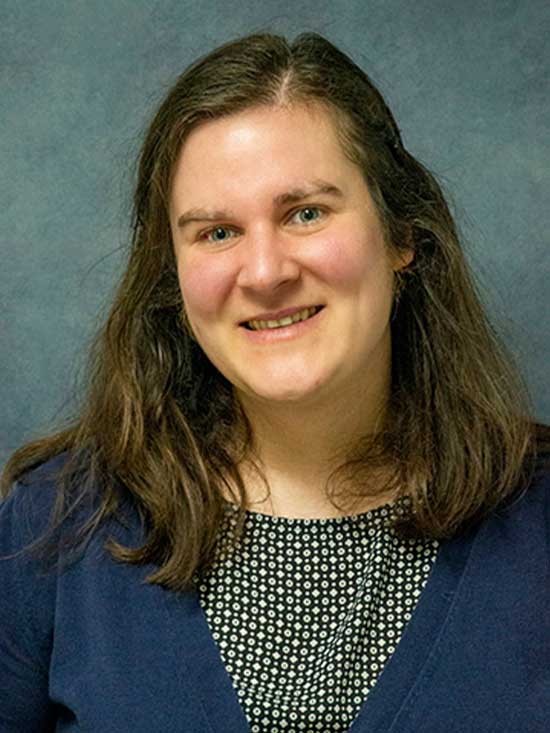
Kimberly C. Mullane
-
A.B., Bryn Mawr College
Ph.D., University of Pennsylvania
Courses taught:
- CHE 103 General Chemistry I
- CRL 107 General Chemistry Lab for Allied Health Services
- CRL 231 Organic Chemistry I Lab
- CHE 345 Physical Chemistry for the Life Sciences
- CHE 409 Descriptive Inorganic Chemistry
- CHE 411 Advanced Inorganic Chemistry
Research Summary:
In my lab, we propose to apply the advances made in photoredox catalysis to the problem of zirconium and hafnium separations. Rather than use the more accessible reduction potential for catalysis, as has been done previously, my students and I aim to exploit the accessible reduction potential to separate zirconium and hafnium complexes. In this proposed scheme, light is used to selectively excite the zirconium complex. Then a weak reductant is added, which will preferentially react with the excited state zirconium complex. With zirconium in a reduced state, its physical properties would be substantially changed from those of hafnium and standard physical separation methods would be used to separate the complexes.

Figure 1. Proposed light–induced separation of zirconium and hafnium complexes.
This project is especially well–suited for undergraduate researchers and makes use of the high–quality facilities and instruments available in the Shared Instrumentation Facility at West Chester University, including Nuclear Magnetic Resonance (NMR), GC–MS spectrometer, Infrared spectrometer, Solvent Purification System, Spectrofluorometer, and UV-vis spectrometers and facilities and equipment such as labs with chemical hoods equipped with Schlenk lines for doing air–sensitive work. Our goals on this project are to:
- Study the interaction of light with related zirconium and hafnium complexes to interrogate how ligand fields can lead to differences in their absorbance properties.
Future aims of the project include:
- Optimize the reaction conditions for photoreduction of our complexes.
- Selectively reduce a single metal from a mixture of hafnium and zirconium complexes.
Scientifically, this project’s significance is its use of a novel approach to metal separation, which could be applied to other metals that need to be separated for industrial applications. However, its more immediate significance and outcome is in training undergraduate students to be researchers capable of problem–solving, designing and executing experiments, and explaining their work to their peers and the scientific community
Selected Publications
- “13C NMR Shifts as an Indicator of U–C Bond Covalency in Uranium(VI) Acetylide Complexes: An Experimental and Computational Study,” Mullane, K. C.; Hrobárik, P.; Cheisson, T.; Manor, B. C.; Carroll, P. J.; Schelter, E. J. Inorg. Chem., 2019, 58, 4152-4163.
- “C–H Bond Addition Across a Transient Uranium Nitrido and Formation of a Parent Uranium Imido Complex,” Mullane, K. C.; Ryu, H.; Cheisson, T.; Grant, L. N.; Park, J. Y.; Manor, B. C.; Carroll, P. J.; Baik, M.; Mindiola, D. J.; Schelter, E. J. J. Am. Chem. Soc., 2018, 140, 11335-11340.
- “Reduction of Carbonyl Groups by Uranium(III) and Formation of a Stable Amide Radical Anion,” Mullane, K. C.; Cheisson, T.; Nakamaru-Ogiso, E.; Manor, B. C.; Carroll, P. J.; Schelter, E. J. Chem. Eur. J., 2017, 24, 826-837.
- “Synthesis and Reduction of Uranium(V) Imido Complexes Containing with Redox Active Substituents,” Mullane, K. C.; Carroll, P. J.; Schelter, E. J. Chem. Eur. J., 2017, 23, 5748–5757.
- “Anomalous One-Electron Processes in the Chemistry of Uranium Nitrogen Multiple Bonds,” Mullane, K.C.; Lewis, A. J.; Yin, H.; Carroll, P. J.; Schelter, E.J. Inorg.Chem., 2014, 53, 9129-9139.
Selected Presentations
* indicates undergraduate authors and presenters
- 259th ACS National Meeting, Philadelphia, PA, March 22–26, 2020, “Synthesis of a phenanthrene-3,6-diol iron complex,” Dante Fuchs*, Walter L. Dorfner, and Kimberly C. Mullane (Poster).
- 259th ACS National Meeting, Philadelphia, PA, March 22–26, 2020, “Coordination of Cu(I) to 3,6-diamine phenanthrene ligands,” Frank MacGregor*, Walter L. Dorfner, and Kimberly C. Mullane (Oral Presentation).
- 259th ACS National Meeting, Philadelphia, PA, March 22–26, 2020, “Synthesis of an N,N-diisopropylamine phenanthrene ligand for coordination to diiron complexes,” Marcel Mitchell*, Walter L. Dorfner, and Kimberly C. Mullane (Poster).
- 259th ACS National Meeting, Philadelphia, PA, March 22–26, 2020, “Synthesis and coordination of N,N-diphenylphenanthrene-3,6-diamine to metal cations,” Daisy Owens*, Walter L. Dorfner, and Kimberly C. Mullane (Poster).
- 259th ACS National Meeting, Philadelphia, PA, March 22–26, 2020, “Synthesis of N,N-(phenanthrene-3,6-diyl)bis(N,N-dimethylethane-1,2-diamine) for coordination to diiron complexes,” Cailey Stevenson*, Walter L. Dorfner, and Kimberly C. Mullane (Poster).
- 259th ACS National Meeting, Philadelphia, PA, March 22–26, 2020, “Synthesis and Electrochemical Analysis of Novel Diferrocene Complexes: A Semester-long CURE Lab in Inorganic Chemistry,” Kimberly C. Mullane. (Oral Presentation).
- 8th Philadelphia Inorganic Colloquium, St. Joseph’s University, Philadelphia, PA, November 9, 2019, “Coordination of Cu(I) to 3,6–Diamine Phenanthrene Ligands,” Frank A. MacGregor*, Walter L. Dorfner, and Kimberly C. Mullane. (Oral Presentation).
- 8th Philadelphia Inorganic Colloquium, St. Joseph’s University, Philadelphia, PA, November 9, 2019, “Synthesis and Coordination of N,N–Diphenylphenanthrene–3,6–diamine to Metal Cations,” Daisy Owens*, Walter L. Dorfner, and Kimberly C. Mullane. (Poster).
- 8th Philadelphia Inorganic Colloquium, St. Joseph’s University, Philadelphia, PA, November 9, 2019, “Synthesis of N,N–(Phenanthrene–3,6–diyl)bis(N,N–dimethylethane–1,2–diamine) Ligand for Coordination to Diiron Complexes,” Cailey Stevenson*, Walter L. Dorfner, and Kimberly C. Mullane. (Poster).
- 22nd Annual Undergraduate Research Symposium, University of Maryland, Baltimore County, Baltimore, MD, October 19, 2019, “Synthesis of N,N–(Phenanthrene–3,6–diyl)bis(N,N–dimethylethane–1,2–diamine) Ligand for Coordination to Diiron Complexes,” Cailey Stevenson*, Walter L. Dorfner, and Kimberly C. Mullane. (Poster).
- 22nd Annual Undergraduate Research Symposium, University of Maryland, Baltimore County, Baltimore, MD, October 19, 2019, “Synthesis and Coordination of N,N–Diphenylphenanthrene–3,6–diamine to Metal Cations,” Daisy Owens*, Walter L. Dorfner, and Kimberly C. Mullane. (Poster) Awarded Second Place Recognition.
- 22nd Annual Undergraduate Research Symposium, University of Maryland, Baltimore County, Baltimore, MD, October 19, 2019, “Coordination of Cu(I) to 3,6–Diamine Phenanthrene Ligands,” Frank A. MacGregor*, Walter L. Dorfner, and Kimberly C. Mullane. (Poster) Awarded First Place Recognition.
